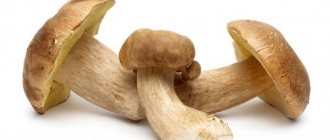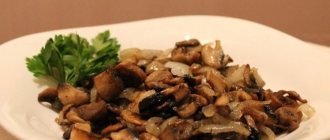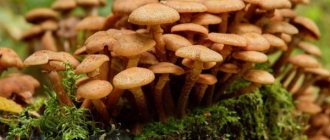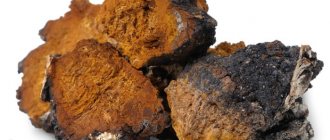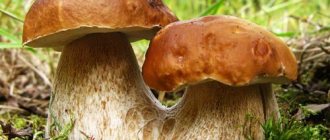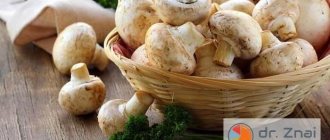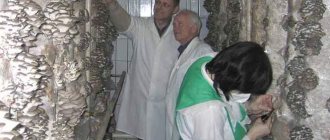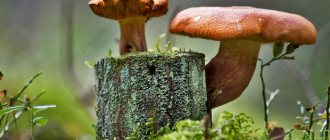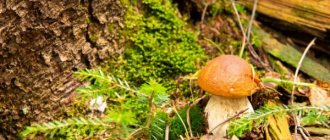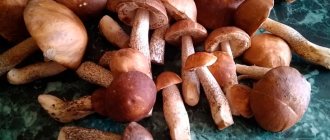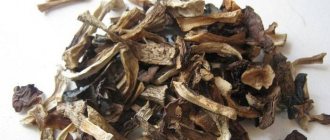The porcini mushroom is the most revered representative of the mushroom kingdom.
Its taste and beneficial properties are difficult to overestimate. Boletus pulp is fleshy and nutritious, so dishes with it are most preferred. White is suitable for preparing literally all types of dishes: from pies to borscht. Mushroom pickers especially value it and try to replenish their supplies as much as possible during the season.
Conditions for the growth of porcini mushrooms: time, place and temperature
The growth conditions for porcini mushrooms have their own specific nuances.
Therefore, when going to the forest, every mushroom picker should know what kind of weather these fruiting bodies like and what temperature they prefer most. Note that the mycelium of porcini mushrooms grows from early spring until the end of autumn. The growth of porcini mushroom depends on a constant flow of air, humidity and a certain temperature. The mycelium penetrates the top layer of soil to a depth of 15 cm. If drought or excessive moisture lasts for a long time in places where the porcini mushroom grows, as well as soil compaction or early frosts, the fruiting bodies develop very poorly and the mycelium becomes dehydrated. Therefore, for good growth of mushrooms, air humidity and heat are needed, especially in the ground layers.
Nutritional quality
Freshly picked porcini mushroom has a calorie content of 34 kcal per 100 g of mass, dried - 286 kcal. Nutritional value – 1.7 g fat, 1 g carbohydrates, 3.5 g protein per 100 g weight. Also disaccharides and saturated fatty acids. Praised for excellent taste in any form. The special nutritional value is that it makes the stomach work actively.
90% of the weight is water, the remaining 10 is divided into proteins, fiber, carbohydrates, minerals and fats.
It contains the most important microelements - iodine, copper, manganese and zinc. Vitamins – PP, C, B1, A. 22 amino acids. The amount of protein depends on the type, age of the mushroom (the younger the better), place of growth and method of preservation. Dried porcini mushrooms are especially good at preserving proteins.
Digestibility of mushroom proteins
It happens more slowly than in animals, since the proteins of the fungus are enclosed in special walls that “do not penetrate” the enzymes of the digestive tract. To improve absorption by the body, mushrooms need to be well chopped, boiled or fried.
Usage
White mushrooms without wormholes are allowed to be eaten in any form - dried, boiled, fried, salted, pickled and fresh. When dried, they do not become dark, leaving a pleasant forest aroma. The sauce goes great with meat and rice. Powder from such mushrooms can be used to season various dishes. Italians love them very much, adding them raw to the ingredients of a salad with Parmesan cheese, seasoning with oil, spices and lemon juice.
Dried mushrooms can be stored for 1 year by placing them in paper bags. The air temperature should be fixed and moderate, and regular ventilation is required.
Air humidity and temperature for the growth of porcini mushrooms after rain
The growth rate of porcini mushroom will be good only at a relative air humidity of up to 60%. If a drought occurs suddenly after the rainy season, the fungus stops growing, even if there is enough moisture in the soil. The fruiting body of the porcini mushroom is not protected from evaporation, so at low air humidity it dries out. Mushroom pickers with extensive experience know that you need to look for porcini mushrooms under moss or in the forest floor.
The second important factor influencing the growth of porcini mushroom is temperature, which will also affect the growth of mycelium and the growth of spores. It must be said that spores can grow at low temperatures, for example at + 8°C.
The optimal air temperature for the growth of porcini mushrooms is from +18 to +28°C. Fruiting bodies grow especially quickly in rainy, warm weather; their growth can continue for a whole month. The average weight of a mushroom during this period is up to 250 g. Already on the fourth or fifth day, the average weight of a young mushroom can reach up to 150-180 g. And after the rains, the growth of porcini mushrooms only increases: sometimes mushroom pickers find boletus mushrooms up to 10-12 cm long with large caps with a diameter of up to 15-18 cm.
Boletus mushrooms (also called porcini mushrooms) live up to 12-14 days. First, the stem stops growing, and after 2-3 days the cap stops growing. As soon as spores begin to form, the fruiting bodies of the porcini mushroom quickly age.
Where porcini mushrooms grow is an important condition for good harvests. These fruiting bodies can grow for several years in a row in one place. However, this condition will depend on how you treat the mycelium itself. Therefore, beginning lovers of “silent hunting” must learn that the stems of porcini mushrooms must be carefully cut off with a knife, leaving the lower part in the ground so as not to damage the future harvest. Next year, when picking mushrooms, you will definitely find boletus mushrooms in the old places.
The growth time of porcini mushrooms depends on the climatic conditions and latitudes in which the forests are located.
Description
The porcini mushroom is a representative of the class Agaricomycetes from the genus Boletaceae, family Boletaceae . Popularly it is also called the bearbird, capercaillie, belevik, and cow. It has a convex cap, which takes on a flat shape as it grows, and can reach 30 cm in diameter.
The surface is usually smooth, sometimes with a small number of wrinkles , which can crack during dry periods. If the weather is cool and damp, the cap becomes covered with a small layer of mucus and becomes sticky to the touch.
Did you know? You can grow boletus mushrooms at home. To do this, it is worth purchasing mycelium or planting fresh caps, which will release young mycelium thanks to spores.
The color of boletus is influenced by the place of growth:
- in a pine forest it takes on a chocolate hue with pink edging;
- among the spruce trees there are specimens of brown-coffee color with a greenish tint;
- in deciduous groves it has a light nutty, yellowish tint.
Young specimens are distinguished by dense white flesh, while old ones are slightly loose, creamy in color . They do not change color during processing. The taste is very good, the aroma is light, becoming more pronounced after heat treatment or drying.
The leg can grow up to 12 cm in height and up to 7 cm in diameter, takes the shape of a barrel, older specimens are elongated and thickened at the base. The color of the leg varies from light brown to brown with a red tint. The narrow tubular layer located under the cap is light yellow or deep olive in color, depending on age. The tubes are no more than 4 cm long, the pores are small and round.
Favorite places to grow porcini mushrooms
These forests are considered the most characteristic landscape for the growth of porcini mushrooms.
These fruiting bodies have a brown cap and stalk and prefer sandy or loamy soil. In spruce-fir forests, boletus mushrooms grow on moss-lichen bedding, which mushroom pickers call “a real porcini mushroom.” Deciduous forests. There are much fewer such forests in Russia than pine forests. However, you can also find porcini mushrooms in them. Birch forests or birch groves are considered the favorite place for the growth of porcini mushroom. The fruit bodies in these places have a lighter shade of the cap and stem, as well as a more pleasant taste of the pulp. Prefers boundaries between overgrown and open areas, as well as edges and well-lit clearings.
Mixed forests. In these forests you can often find clusters of porcini mushrooms. This may be influenced by the original undergrowth of mixed forests. In addition, birch often grows in them, which can provide high yields of boletus.
Porcini mushrooms grow in forested areas all over the world, except Antarctica and Australia. As we have seen, they grow in deciduous, pine and mixed forests. These fruiting bodies have conquered almost all of Europe, North and South Africa, Central America, Turkey, China, Japan, Siberia and the Far East. In forest-steppe zones, the abundance of porcini mushroom growth noticeably decreases, but the boletus disappears completely when moving to the steppe zone.
Knowing the favorite places for the growth of the porcini mushroom and the time of its fruiting, you can safely go into the forest and look for these amazingly tasty and aromatic fruiting bodies. Having found such places, carefully cut off the legs with a knife so as not to damage the mycelium. In the coming years, you will definitely collect more than one basket here.
What time do boletus mushrooms grow? Cooking methods
Freshly picked mushrooms must first be cleared of debris and grass, the base at the stem must be cut off and the gray shell of the stem must be removed. Fill with cold water and rinse thoroughly. And then you can
— Boil
Pour water into a large saucepan and add salt per 1 kg. mushrooms 1 tbsp. salt. You can put the mushrooms in cold water, or in boiling water. The first water is usually drained and filled with clean cold water. Boletus mushrooms should boil for about 40-50 minutes. You will need to remove the foam from time to time. The finished mushrooms sink to the bottom of the pan.
- Fry
Usually, before frying boletus mushrooms, they are boiled for 20 minutes. Fry for about 30 minutes, uncovered. Or you can immediately put clean chopped mushrooms into the frying pan and cover with a lid. First they will stew, release the water, and then fry. Later you can add potatoes to them. Often all this is topped with sour cream.
— Salt
- 120 ml water;
- 40 g salt;
- 2 cloves;
- 4 bay leaves;
- 5 peppercorns;
- several sprigs of dill.
Peel the mushrooms, rinse, cook for 15 minutes, drain in a colander and place in jars, sprinkling them with salt. Prepare the brine separately: put cloves, dill, pepper and bay leaf into boiling water. Pour the brine over the mushrooms and put them in a dark, warm place. After a month, the mushrooms are ready.
— Marinate
For 1 kg. mushrooms you will need:
- 2 tbsp. l. salt;
- 2 tbsp. l. vinegar 9%;
- 2 tbsp. l. lemon juice or citric acid;
- 1/2 tsp. allspice peas;
- 5 bay leaves.
Peel, wash, cut the mushrooms, boil in plenty of water for 50 minutes (do not forget to remove the foam). Then add vinegar and seasonings to the water, cook the mushrooms for another ten minutes. Then remove the mushrooms from the pan with a slotted spoon and immediately place them in jars and pour the same broth on top. Roll up the jars, let them cool and put them in the cellar until winter.
— Dry
For drying, select boletus mushrooms without damage are selected. Clean, rinse well, place on a towel or napkin to drain. Then spread on baking paper and dry in the oven at a temperature of about +50 degrees with the door open. Mushrooms can be dried whole, large ones can be cut.
The boletus mushroom is one of the most common in Russia and neighboring countries. The aroma and taste allow it to be used for preparing delicious dishes and preparations. In some countries, this mushroom is not considered valuable for cooking, but in our latitudes it is one of the indispensable products included in national dishes.
Boletus mushrooms are not grown on an industrial scale - you can only get such a delicacy in the forest or birch grove, collecting the best specimens yourself. But, before you go mushroom hunting, you need to read the exact description of this mushroom and find out where and when it grows.
Conditions for the growth of porcini mushrooms
The golden autumn time is the mushroom picking season. The most popular among lovers of “quiet hunting” is the porcini mushroom. The growth conditions for porcini mushrooms have certain nuances. For this normal development of the species, the correct temperature regime, moisture in the surface layers of the soil and good lighting are required.
Conditions for the growth of porcini mushrooms
Temperature
The second important indicator of intensive growth is temperature. Mycelium grows even at low temperatures - about 8 ° C, but it develops slowly in such conditions.
The optimal temperature varies between 18-28 °C. Mushrooms grow quickly during the rainy and warm weather seasons. During this period, the duration of their growth can be 1 month.
During this period, porcini mushrooms reach truly gigantic sizes - the length of the leg is 10-12 cm, the diameter of the hat is 16-19 cm. The average weight of such specimens is 0.2-0.3 kg. The life cycle is about two weeks. First the stem withers, and after a couple of days the cap turns black. When spores appear, the fruiting bodies of adult specimens age and are destroyed.
Obtaining good harvests depends on how correctly the mushroom picking is carried out. Boletus mushrooms appear in the same place for several years in a row if the mushroom picker leaves the lower part of the stem in the ground when cutting it. Next year there will be no need to look for new mushroom places; a good harvest will be obtained from last year’s mycelium.
Mushroom places
Porcini mushrooms are collected in almost all countries of the world, with the possible exception of the Arctic and Australian zones. Sometimes this species can be found in Chukotka and Kamchatka. Porcini mushrooms are also found in the taiga. Seasonal “hunts” begin annually in early June, with the second gathering taking place in mid-July, and the third at the end of October or beginning of November.
Mushroom pickers get the largest harvest in mixed forests in the European part of our country. Often porcini mushrooms (boletus mushrooms, as they are also called) appear in places where lichens and moss accumulate. They can be found in forest areas with birch, oak, hornbeam, and fir. You can also meet them in a pine forest, although in small numbers.
There are several varieties:
The first species should be looked for in beech, oak and hornbeam forests. The second is in birch groves, on the edges and along forest paths. Pine trees are found in a pine forest, and sometimes a good harvest can be obtained in a spruce forest. Spruce trees are characteristic mainly of spruce and fir forests; sometimes they can be found in pine forests.
Useful and harmful properties
Boletus mushrooms contain large amounts of vitamins A, B1, C, D.
- In addition, boletus is rich in the following substances:
- riboflavin - responsible for the healthy condition of nails, hair and skin, promotes normal functioning of the thyroid gland;
- sulfur and polysaccharides - prevent cancer;
- lecithin ether - cleanses the walls of blood vessels from cholesterol;
- amino acid ergothioneine - stimulates regenerative processes in cells;
- glucan - promotes the formation of strong immunity, protecting the body from viruses, bacteria, fungi.
Due to its rich composition, boletus is used in the treatment of:
- tuberculosis;
- metabolic disorders;
- angina pectoris;
- skin ulcers;
- frostbite;
- atherosclerosis;
- anemia.
Important! Porcini mushroom contains a lot of useful protein, which is poorly absorbed by the body due to the chitin in its composition. But if you eat the dried product, the digestibility rate will increase to 80%.
- The harmful properties of boletus mushrooms include:
- tendency to absorb heavy metals and toxic substances when growing near roads and in industrial areas;
- the ability to cause a negative reaction in the body in the form of poisoning or gastrointestinal upset from consumption due to improper drying or storage of prepared mushrooms;
- worsening health conditions when the product is consumed by people who suffer from liver and kidney diseases.
Mushrooms are a heavy food - they take a long time to be digested by the body, so it is recommended to consume them in small quantities in combination with vegetables. It is also not recommended to give this product to children under 12 years of age, since the body is not yet able to digest the chitinous shell, which can lead to problems with the digestive system.
Thus, porcini mushroom is not only tasty, but also a very healthy product that grows everywhere. Nowadays, boletus collection has been greatly simplified, as you can find many places on the Internet indicating the coordinates of mushroom meadows. In order not to confuse the edible boletus mushroom with a false porcini mushroom, it is recommended that you carefully read the information in the article, studying the main differences and characteristics of its growth.
Breeding methods at home
Two schemes for growing porcini mushrooms are used
Mushroom pickers use two schemes for cultivating this species at home:
- extensive method: it involves artificial breeding in the forest or in the garden;
- intensive method: cultivation is based on creating conditions close to natural in a greenhouse or other specially equipped places.
Irina Selyutina (Biologist):
Having set out to grow porcini mushrooms at their summer cottage, a person is faced with the question of where to get them. There are several ways to get mycelium:
- Collect yourself: when picking mushrooms, a section of mycelium (with mushroom) is cut out around the selected mushroom with a sharp knife. The size should be at least 15x15 cm, but there is no need to cut a huge “tablecloth”. There is no need to plant it in one piece. Can be divided into several parts and planted in an already prepared mixture. The mother mycelium is covered on top with loose forest soil (from the same area where the mycelium was taken) in a layer of at least 5 cm.
- Buy fresh porcini mushrooms (not in the supermarket, but at the market).
- Buy mycelium in a specialized store.
Each mushroom grower determines for himself the method of acquiring mycelium and growing it. It all depends on the person and the desire to get the desired result.
In the garden
Growing porcini mushrooms on the garden plot is carried out in several stages.
Preparing the site
Preparatory work on the site begins with:
- Growing location definitions: sunny place with slight shade.
- Search for individual tree species on the site: determining which mushroom grows with in the forest. Therefore, they should provide the same neighborhood at home. Planting is done in the spring.
- Cleaning and watering: About a month before planting, the place selected for the mushroom bed should be cleared of weeds and garden debris and watered daily.
- Substrate preparation: it is worth preparing crushed tree bark and dry leaves in advance. Both components are added to the soil when planting mushrooms.
Harvesting "seedlings"
Porcini mushrooms are collected for planting in a pine or mixed forest. When choosing mushrooms for “seedlings”, you should follow some rules:
- You need to collect only those mushrooms that grow under the same trees as in your garden. Preference is given to the densest and largest specimens.
- After the harvest has been harvested, it should be immediately processed - separate the caps from the stems and chop the caps.
- Next, a special solution is prepared from settled water (without chlorine, leave for at least 24 hours), several crystals of potassium permanganate (pale pink solution) and 10 pieces of refined sugar.
- The crushed raw material is kneaded to a mushy consistency, poured with this solution, mixed and left for a day.
- Then filter through cheesecloth. The solution with spores is evenly spilled over the bed, the remaining raw materials in the gauze are evenly laid out on top of the substrate.
Many mushroom pickers use “wild seedlings”. To do this, dig up a section of mycelium (approximately 25x25 cm), transfer it to the planned planting site and dig it in.
In the greenhouse
Porcini mushrooms can be successfully grown in a barn
Any room with proper conditions is suitable for propagating porcini mushrooms in a greenhouse. This could be a barn, basement, cellar, greenhouse or hangar.
Preparing the site
To successfully plant this type of house, it should provide two conditions:
- temperature within 8-12 °C;
- high air humidity at 85-90%.
Such a room must have good ventilation, which is necessary for intensive growth of the porcini mushroom.
During the incubation period, the mycelium does not need light, but during the appearance of fruiting bodies, the plantings are provided with daylight for 5 hours. The main thing is that the light is not too bright, otherwise the mycelium will simply dry out.
Preparation of material
With this method, ready-made planting material is used, intended for the Dutch method of growing mushrooms. The Dutch have developed a unique method in which mushroom growers get the best yields when growing crops indoors.
“Wild seedlings” will not give such results and their survival rate is quite low. The process of preparing for planting is the same as when planting on the site.
Landing rules
Porcini mushrooms are planted in greenhouse conditions in several ways:
By the way. Some people successfully grow this mushroom in apartment conditions.
The process of planting and preparing a planting hole in greenhouse conditions is no different from the natural method of growing mushrooms. The main thing is that in such a room all the above conditions are met.
In the basement, barn or cellar, bags or boxes are used for planting mycelium. It will grow especially well in wooden (eco-friendly, “breathable” containers) boxes. A wooden container is filled with a pre-sterilized mixture of hay, corn cobs, sawdust, seed husks and buckwheat. First there is a layer of substrate, then a layer of mycelium, again a layer of substrate, and so on, alternating until the very top. The top layer must be a planting mixture. The same principle applies to planting in bags. After planting, holes are made in them.
Attention! If you are planning long-term plantings of mushrooms, then it makes sense to treat the tree with special preparations that prevent rotting, for example, Pinotex or Belinka.
Boxes and bags are placed on racks at a distance of 15 cm from each other.
Product usefulness
The porcini mushroom is considered one of the valuable, useful tubular specimens. The nutritional value of one kilogram of dried product replaces 3 kilograms of meat. It is better to eat them dried, since in this form the taste is better revealed.
Boletus mushrooms are also pickled, boiled, and fried. However, the product prepared using these methods will not differ from other tubular ones (for example, if you take boletus). Fresh boletus does not smell, but the dried mushroom emits a unique aroma.
In addition, boletus mushrooms are believed to be a means of preventing cancer. Of course, treating oncology with the help of porcini mushrooms is pointless and, moreover, it is life-threatening. At the same time, it is acceptable to assume possible preventive properties.
In folk medicine, there are recipes using dried mushrooms to cure chronic bronchitis and asthma.
Knowing the area in which boletus grows and their frequent accumulation is observed, and being observant, you can safely go to collect a royal specimen.
How does porcini mushroom grow?
In autumn, white mushroom can be found throughout Russia. Although the mycelium of this representative of the mushroom family functions from the beginning of spring until cold autumn, the main period for harvesting the mushroom harvest occurs in warm September and the first half of October. Chunky porcini mushrooms can be found both in cozy deciduous and cool mixed forests. Moreover, representatives of this fungal genus prefer old, mature trees, more than half a century old. Strong, elastic mushrooms are often hidden under powerful roots or under a layer of moss.
The first wave of boletus mushrooms is expected by mushroom pickers in June, and then in late July - early August. However, during hot summers, the period of mushroom hunting is no more than a few days. Much more productive time occurs in the first half of autumn. It is at this time that the so-called “greenhouse effect” occurs on the earth - the soil, calcined over the summer, generously gives up its heat with the difference in night and day temperatures.
Symptoms of poisoning
You already know what a porcini mushroom is, when to collect it and where. However, it is necessary to understand what symptoms occur during poisoning and what to do in this case. As practice has shown, the first signs appear no later than two hours after consumption.
In case of poisoning, nausea, vomiting and severe diarrhea occur. The temperature rises to almost 40 degrees, and the hands and feet become very cold and chills begin. In some cases, hallucinations are noticeable.
At the first signs of poisoning, you should take activated charcoal, drink as much cold water and strong, chilled tea as possible. In the meantime, you need to call a doctor or an ambulance. Only with proper and timely treatment does a person have the opportunity to recover within three days.
Conditions for growth
The boletus mycelium grows 10–15 cm deep into the soil and is very demanding of moisture. Therefore, even with slight dehydration of the soil, the mycelium dries out and stops bearing fruit. In addition, whites are very picky about air humidity - it must be at least 60%. Mushrooms stop growing even in moist soil provided there is atmospheric dryness.
That is why representatives of this genus most often prefer to grow under the cover of mosses and lichens, which provide them with the necessary microclimate. The porcini mushroom grows quickly at an air temperature of +18...+28°C. And the favorite period of boletus, when they grow as large as possible in a short time, is warm and rainy autumn weather.
How will they grow
Experienced fans of mushroom hunting note that 15–20 days after warm downpours, white specimens can be found in the forest, the cap diameter of which reaches 20–25 cm. It is worth noting that the lifespan of white mushrooms is not as long as is commonly believed - these mushrooms are at peak maturity reach 12–14 days after the start of growth.
Upon reaching 10–12 days, the mushroom stem stops growing, while the cap continues to increase in diameter for another 2–3 days. After this, the process of decay begins in the pulp, and it loses its good nutritional properties.
The best time to collect young porcini mushrooms, which are perfect for pickling and pickling, is 4–5 days after a good rain. In addition, such mushrooms have not yet been attacked by parasites, which are very fond of dense, aromatic pulp.
Video: How porcini mushrooms grow
Per night
There is an opinion that boletus can grow literally overnight. However, in fact, the porcini mushroom is not so fast - its growth rate entirely depends on the surrounding humidity and air temperature both at night and during the day. Representatives of this mushroom family are more demanding of environmental conditions than its relatives, for example honey mushrooms or boletus. At +10°C, the white cap grows in diameter by about 1–1.5 cm overnight.
Per day
In a day, the boletus can grow by 2–3 cm and, already a couple of days after a warm downpour, there is a chance to stumble upon a clearing of young and strong white ones. Boletus mushrooms can settle on it either singly or in entire families. Experienced mushroom pickers who devote a lot of time to collecting whites know hidden places and often notice an interesting fact: walking through favorite mushroom places, you can collect a good harvest of whites even where yesterday there was no hint of mushrooms hiding under the leaves.
During the week
If the weather is favorable, then you shouldn’t spend a long time going for a mushroom harvest. In a week, under favorable conditions, boletus mushrooms can grow to truly impressive sizes. If we talk about how much such a mushroom weighs, then the average weekly boletus reaches a weight of 150–200 grams. There are often larger representatives. The diameter of the cap of such specimens can reach 20–25 cm.
How long do they grow after rain?
A small boletus emerges to the surface of the soil literally in the first hours after a warm downpour. Its weight is tiny, about 2 grams. However, with the right amount of moisture in the environment, maintained night and day throughout the entire period of growing the mushroom, there is a real chance of finding a white one, the weight of which reaches 300–400 grams. After all, it’s not for nothing that there is a common expression: “They grew up like mushrooms after the rain.”
At high temperatures
Like many of its relatives, boletus mushrooms do not like heat. If the air temperature exceeds +28°C and the humidity drops below 60%, the plant body dries out. This is due to the inability of the fungal body to delay the process of evaporation of moisture from the surface of the plant. In addition, in the heat, the boletus mycelium also becomes dehydrated, which has a depressing effect on the entire boletus harvest.
A cut porcini mushroom loses its beneficial properties without treatment 10 hours after collection.
When it's cold
The boletus also stops growing with the arrival of cold days, when the average daily temperature drops below +10°C. Low temperature disrupts the chemical processes in the mycelium and body of the boletus, which causes the growth of whites to stop. Therefore, with the onset of the first autumn frosts, it is better to look for porcini mushrooms under the roots of old trees and in secluded places surrounded by fallen leaves. There, for some time after the onset of cold weather, a microclimate remains suitable for the full growth of boletus mushrooms.
Varieties of white specimens
There are a large number of types of mushrooms, but the most popular and common ones include:
- oak;
- spruce;
- birch;
- pine.
Oak boletus
Oak specimens include boletus with a brownish, brown and grayish tint to the cap, which can be covered with white cracks. In diameter it ranges from 8 to 25 centimeters. Initially, the tubes on it are white, then they become yellowish-greenish.
The leg is approximately 20 centimeters. It is loose, with a noticeable mesh pattern.
Boletus collection takes place in the summer and autumn months. It bears fruit in layers. This earliest subspecies appears at the end of the spring month.
It is important to note that the oak specimen is similar to the gall fungus. The latter grows in coniferous forests. On its leg there is a black mesh with pink tubes.
Boletus has medicinal properties. It is used in the treatment of:
- disrupted metabolic process;
- weakness after illness;
- digestion.
Spruce subspecies
This species has a convex, sometimes depressed cap. Its skin is velvety, wrinkled, shiny and sticky in wet weather. The edge of the cap often has an acute-angled shape. Its shade is brown, brick red. The tubes are spacious and can be easily separated from the hat. Initially they have a white, grayish color, and by maturity they have a yellowish, olive color.
Growing specimens with thick flesh. Further, it is spongy, with a white color, a pleasant mushroom aroma and taste.
The pedicle is 20 cm high with a tophi downwards. Its color is white, brown.
This subspecies bears fruit in 2 stages. First individually in the last days of May. Next heavy cover in mid-June.
This specimen is similar to other types of porcini mushrooms (however, spruce mushrooms are more medicinal than oak mushrooms). Of the unusable specimens, the gall mushroom is similar to it.
Pine boletus
It has a fleshy convex cap. Its skin is smooth and velvety, and sticky in wet weather. Boletus has a brownish-red, dark brown, purple, greenish, and bluish color. Its edge is often light. Initially, the tubular layer is white, then yellow, olive-yellow. The white flesh is reddish-purple under the skin. The taste and smell of the mushroom are characteristically mushroom.
The leg has a maximum height of 12 cm. It is thick, fleshy, thickened towards the base. Its color is light brown, yellowish. The leg is covered with a thin red mesh.
The pine subspecies can easily be confused with the bitter inedible gall specimen, which has a black mesh on the leg, a pink tubular layer.
Collection time
The best time for harvesting mushrooms is considered to be warm September and the first half of October. On fine autumn days, in just a few hours of walking in the forest you can collect baskets full of whites. Especially if you know about the favorite habitats of boletus mushrooms. The fertile mushroom time usually lasts until regular morning frosts, and even then in the forest you can find strong, slightly frozen boletuses growing under moss and leaves, along with other mushrooms - redheads, boletus and honey mushrooms.
How to collect correctly
Anyone who has ever gone to the forest to pick mushrooms knows the basic rules for picking:
- The mushroom trophy cannot be pulled out of the ground along with the roots.
- When going out on a “quiet hunt,” you should stock up on a small, sharp knife, with which you cut off the prey above the soil surface. Thus, the mycelium is preserved and grows, and next year you can count on a generous harvest of whites in the same place.
- Before going into the forest, you should stock up on a long stick or staff to carefully dig out mounds of leaves, moss and earth, under which strong families are hiding.
Autumn is a great time to visit a quiet, colorful forest, filled with the smell of mushrooms and fallen leaves. And what could be better than a basket of strong boletus, brought from a walk and filling everything around with a mushroom aroma.
Sources:
https://grib-info.ru/spravochnik-gribnika/usloviya-rosta-belyx-gribov.html https://fermoved.ru/gribyi/gde-i-kogda-rastet-belyj.html https://fermer. blog/bok/griby/sedobnye-griby/belyy-grib/13388-kak-rastut-belye-griby-v-lesu.html
